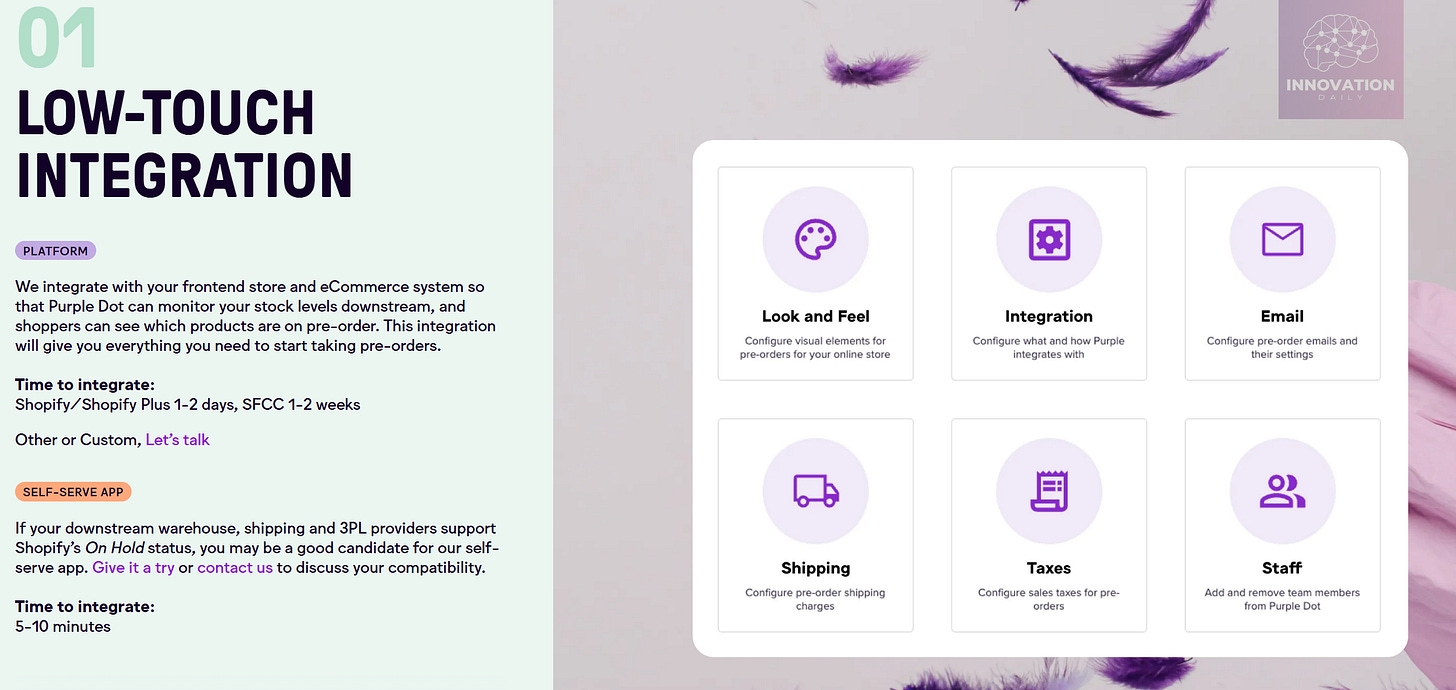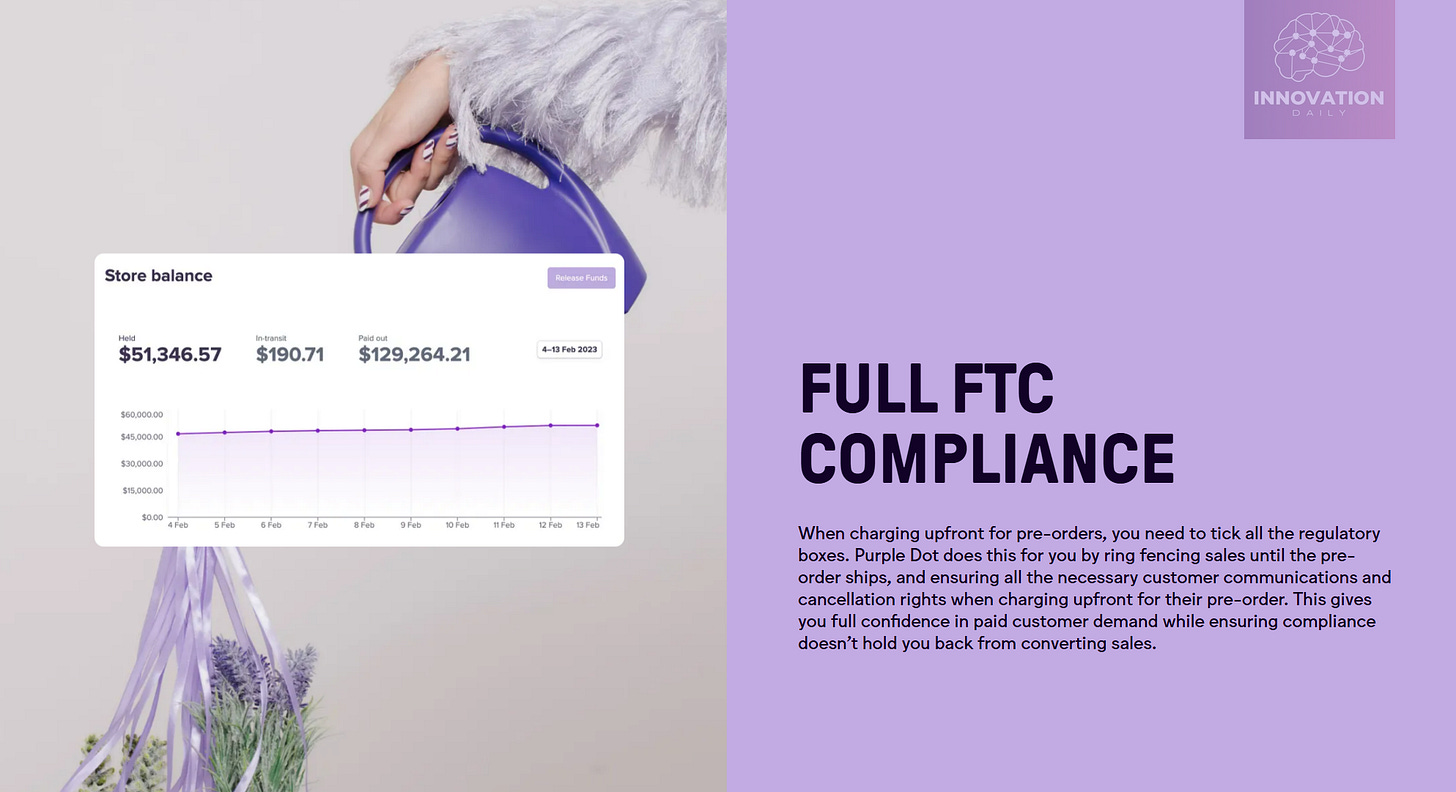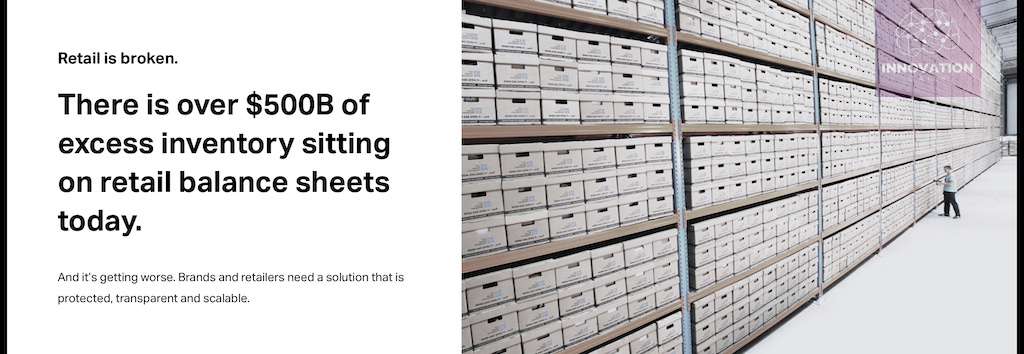The Invisible Shelf
Today’s featured startup is tackling retail’s $500B inventory problem — by selling before stock even arrives.
Project Overview
Purple Dot is a platform that integrates with your online store to allow for preorders. This functionality enables retailers to accept preorders for upcoming products or items that are out of stock.
The integration process is quick: 1–2 days for stores built on Shopify and 1–2 weeks for those using Salesforce Commerce Cloud (SFCC).
The primary benefit of Purple Dot is streamlining the process of accepting, processing, and tracking preorders, making it as simple as handling regular orders. No more tracking with separate Excel sheets or remembering who ordered what and when to fulfill those orders.
Customers are often reluctant to place preorders because they don’t understand the process or when the order will be fulfilled. Purple Dot solves this issue by making preorders transparent not just for sellers, but also for customers. Each customer has a section in their personal account showing a list of preorders with their current status, and they automatically receive email updates whenever their preorder status changes, including the expected delivery date.
When sellers take payment for preorders of out-of-stock items, they must comply with certain legal requirements, such as ensuring the customer agrees that they are ordering something that is not currently in stock. The customer also gains special rights to cancel the preorder. Purple Dot automatically handles these requirements by setting up the necessary checkboxes and rules when the customer places a preorder on the seller’s website.
Preorders are seamlessly integrated into regular orders, meaning customers can combine preorders with items that are already in stock in a single order. The seller can decide how to handle shipping costs: for a single delivery for the whole order, for each fulfilled delivery, or offer free shipping.
Similarly, the seller can configure how to charge for preorders: the full amount upfront, the full amount upon fulfillment, or 50% upon ordering and 50% upon fulfillment. In the latter two cases, the platform will automatically charge the customer’s card when the delayed order is fulfilled.
Because the platform integrates with the online store, it tracks when an item is out of stock and automatically switches the order form to a preorder form with the appropriate checkboxes and payment rules.
Before placing a new order with suppliers, the store owner can consult Purple Dot’s preorder report to adjust the order size. Purple Dot also provides insights on the optimal order size based on sales data and preorder trends.
Purple Dot claims that enabling preorders can increase sales by 50% per unit of time, with up to 95% of incoming stock already sold before it arrives.
One client reports they are currently able to sell 60% of incoming stock through preorders. Another claims that after integrating Purple Dot, orders for out-of-stock items increased by 89%.
Purple Dot has raised £8 million ($10.04 million USD) in new investments, bringing the total funding for the project to $15.8 million.
What’s the Gist?
Purple Dot has been described as a “pre-commerce” platform, which is a term that might soon become commonplace. This is because platforms that facilitate preorder collection and fulfillment could become one of the go-to solutions for solving the inventory overflow problem faced by retailers.
This issue is significant: retailers currently have $500 billion worth of goods sitting in warehouses, and these goods move slowly. For example, within two months, only 24% of clothing sold to a store is sold off the shelves, 45% within six months, and 69% within a year. Cosmetics have a slightly better turnover rate, with 48% selling within a year.
Unsold goods represent frozen capital for the retailer, which cannot be used to generate profit. This is why stores are willing to pay for platforms that help solve this issue.
Preorders, or "pre-commerce" as with Purple Dot, offer one such solution.
Other solutions include using AI to predict sales more accurately, enabling stores to buy exactly the amount they can sell in a given time period. For instance, Syrup uses AI to predict future clothing sales with precision down to specific colors and sizes. This startup raised $25.1 million in investments.
Another solution is the creation of closed marketplaces where retailers can sell their excess stock to other stores, outlets, or distributors. One such platform, Max Retail, raised $20.9 million in investments, while Ghost, a similar platform, raised $68 million. Ghost differentiates itself by focusing exclusively on wholesale transactions.
However, there’s always a downside. Precise stock orders may result in understocking on certain items, missing out on potential sales due to existing demand.
To solve this, platforms like Carro allow retailers to combine their physical inventory into one “virtual warehouse,” enabling the shipment of products from other stores if needed. While this strategy earns the seller only a commission on the resale, it satisfies the customer and encourages repeat business.
Other platforms, such as Stockly, offer similar solutions. Stockly raised $17.5 million in investments.
Key Takeaways
The overarching trend is the creation of platforms to reduce the inventory overflow problem faced by retailers. This issue is large, which is why online stores are not only willing to pay for such platforms but are also eager to invest in them.
Purple Dot’s approach seems the simplest and most elegant. There’s no need to create marketplaces or find resellers willing to buy unsold stock. Nor is there a need to build sophisticated AI machines that can predict demand, which will always have some margin of error.
Instead, a platform that simplifies and makes preorders transparent is sufficient.
With the current state of logistics and production planning, the physical location of an item in a seller’s warehouse may eventually become irrelevant. The key factor will be the customer’s acceptable delivery time, which will depend on logistics speed and the store’s ability to order small quantities from suppliers.
This mirrors how cloud storage systems like Dropbox, OneDrive, or Google Drive work: it doesn’t matter whether your file is on your computer or in the cloud if it opens quickly when you click on it. The user benefits from saved space on their device and the flexibility of accessing files from any device.
As such, online stores of the future may become "Dropbox-like" platforms.
And this is already happening. For example, Trendsi, a platform I covered in 2022, allows online stores to display products from any connected manufacturer and accept orders for items that are either in the manufacturer’s warehouse or not yet produced. The manufacturer then fulfills these orders as needed. Trendsi raised $30 million in investments.
It’s possible that Purple Dot will evolve in a similar direction, connecting suppliers and manufacturers to ensure a seamless and optimal preorder process for all parties involved.
As Paul Graham said, to create a successful startup, you need to imagine yourself living in the future and then create the pieces that are missing to make that vision a reality. If we envision a future where online stores truly become "Dropbox-like" platforms, creating an e-commerce startup that integrates this concept could be a viable strategy.
Company info:
Puple Dot
Website: getpurpledot.com
Last round: £8M, 14.05.2024
Total funding: $15.8M across 3 rounds













